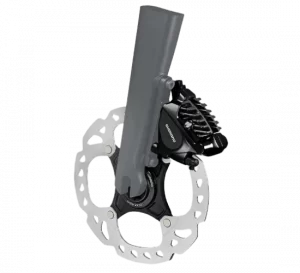You just bought a bike or already have one and want to consider the two options in disc brakes. The problem is, you are not sure which disc brake you should go with and why?
Don’t worry, I can help with that. The confusion of choosing between a post mount and a flat mount disc still exists.
Contents
Post Mount Vs Flat Mount Disc Brakes

So, to clear both these options for you, I will discuss with you post mount vs flat mount disc brakes in detail today. But, before I start with the comparison, I want to ask, are you familiar with the term disc brakes and its types? No? You can find out about it down below:
What are Disc Brakes?
Disc brakes have a circular metal disc that is mounted on the hub of the wheel. The metal disc rotates through a caliper containing the brake pads. When the brake lever is squeezed, it applies the pads to the rotor. As a result, the bike slows down.
These disc brakes come in different sizes. A large disc helps in slowing down faster as compared to a small disc. Disc brakes improve the stopping power of a bike which is not possible with a rim brake. That’s the reason they are gaining more popularity over the years.
Disc brakes have different types based on the mounting systems:
1. Post mount
2. Flat mount
3. International Standard (IS)
As you know, the basic purpose of a brake is to slow down or stop the bike. So, what makes these three types differ from one another? The major difference between these types is in the placement of the bolts. We are only going to be looking at post-mount vs flat-mount MTB in today’s article.
Post Mount vs Flat Mount Disc Brakes
1. Post Mount
Post-mount brakes are commonly used on mountain bikes. Most modern frames and forks use these mounts. The two bolts are 74mm apart from each other. Unlike the IS mount, these are directly screwed into the frame. In the case of post-mount calipers, the bolts thread through the calipers first and then inside the fork. Besides, there is no need for an adapter to install post-mount brake calipers. You would only require an adapter when the rotors are larger in size than the size of the post mount.

The reason for their wide usage is that they are easily installed and adjustable. The first gravel bikes also had post-mount brakes. Post mount brakes are heavy, making them perfect for mountain bikes but not suitable for road bikes. These are comparatively simple, inexpensive, and more efficient.
2. Flat Mount
Shimano was the first one who introduced flat mount disc brakes. A flat mount had the same basic caliper and the inner workings as a post mount. The bolts of a flat mount caliper first go through the frame and then inside the calipers.

The flat mount is best for road bikes due to their low weight but now even cross-country (XC) mountain bikes also have flat mounts.
Down below are some more questions answered for you that you wouldn’t want to miss out on.
Frequently Asked Questions
What is the difference between flat mount and post mount disc brakes?
The major difference between a flat mount and post mount disc brakes is the screwing of bolts. Apart from this, a bike with a flat mount disc brake is lighter as compared to a bike with a post mount disc brake.
What is a post-mount brake?
Designed especially for mountain bikes, a post mount brake screws directly into the bike’s frame without the need for an adapter.
Can you use flat mount brakes on the post mount frame?
You can use flat mount brakes on a post-mount frame or fork with the help of a post-to-flat mount brake adapter. This particularly helps cyclists who wish to use their mountain bike frames for road riding.
What is the difference between IS mount and post mount?
If we talk about post mount vs IS mount disc brakes, IS (International Standard) mount is the one where the two bolts are 51mm apart and the placement of the bolts is perpendicular to the wheel. On the other hand, the two bolts of a post mount are 74mm apart. These are directly screwed into the fork and are parallel to the wheel.
What is a flat mount brake caliper?
Introduced by Shimano in 2015, a flat mount caliper is relatively sleeker and simpler than a post mount caliper. This is more common for road bikes. If you observe a flat-mount caliper, you’ll see that it sits directly on the fork blade or the chainstay. As a result, it tends to take less space as compared to a common post-mount caliper.
Conclusion Post Mount and Flat Mount Disc Brakes
To sum up, by now you can tell that there are no huge differences between a post mount disc brake and a flat mount disc brake. However, keep in mind that a flat mount disc brake is expensive and lowers your bike’s weight.

Hi, This is Catharine Pendrel, a professional cyclist and founder of Bikeoure. I have been riding bikes for more than 23 years and writing about cycling and other outdoor magazines for about 5 years. Mountain biking has been my passion ever since I first came across it a decade ago. I participated in various MTB tournaments and won numerous mountain trail races.
I started Bikeoure to share my expertise and cycling experience with cyclists all around the world to make them addicted to cycling. My cycling and solo traveling expertise help new cyclists find the best and latest gear in the market for their cycling adventures.